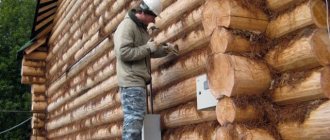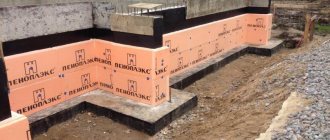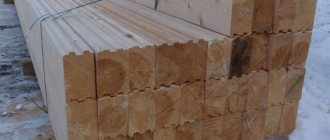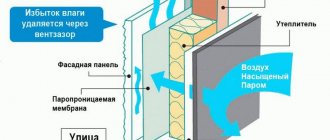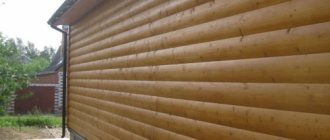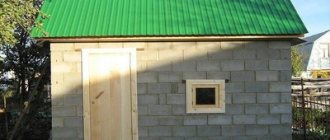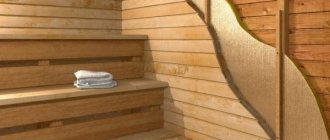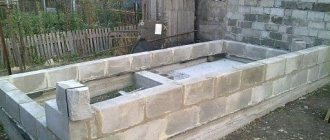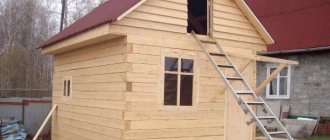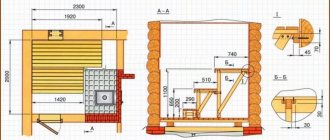Hi all! Having built a bathhouse from timber, many people think about how to extend its service life as much as possible, as well as preserve its appearance and provide the necessary level of heat inside. Therefore, the question arises - how to insulate a bathhouse made of timber from the outside, and whether it is necessary to do this at all.
Practice shows that the bathhouse is lined with insulation mainly from the inside. Much less often additional external insulation is carried out. There are several objective reasons for this.
So, when thinking about what you can use to cover a bathhouse, first decide whether there is a need for such a procedure. If yes, then clarify what is better to take and how to carry out the work in order to achieve the expected result.
When to start insulation and finishing work in a new wooden bathhouse
If the bathhouse is made of timber or is a log house, then you must immediately keep in mind that in the first three years after construction it will shrink noticeably (then less). On average, this is 20 cm in the first 3 years.
During shrinkage, cracks form - all this time you will be patching them. And the most important thing: if finishing was carried out immediately after construction, and it was nailed down firmly, then the lathing will not allow the bathhouse to sit properly.
Therefore, it is either left unfinished, or grooves are cut out in the sheathing so that the nails gradually slide into the grooves.
It’s better not to finish it, because you have to caulk the cracks both inside and outside, and the sheathing will get in the way. The bathhouse needs to be allowed to shrink (at least) for one year. And when its results are already visible, you can think about insulation and finishing work.
Inter-crown insulation and sealing of cracks
Over time, wooden buildings inevitably shrink, which causes gaps to appear between the crowns. Those, in turn, open the way for drafts, so the first stage of the fight is to seal them.
The initial stage of interventional insulation occurs during construction. Timber (including profiled) and round timber are laid with tow tape or jute. Subsequently, this will be internal interventional insulation.
In addition to the internal, there is also an external one, which has to be periodically updated. The resulting cracks can be filled with tow, jute, natural moss, or you can use modern materials, but only those designed for wood.
IMPORTANT! Plumbing sealants, putty and polyurethane foam are not suitable for sealing cracks in a bathhouse made of logs or timber. They are inelastic, designed for a constant gap size (while wood changes), they have poor adhesion to wood, insufficient heat resistance, harmful emissions, etc.
flaws. Over time they crumble out of the cracks
They are inelastic, designed for a constant gap size (and in wood it changes), they have poor adhesion to wood, insufficient heat resistance, harmful emissions and other disadvantages. Over time, they crumble out of the cracks.
The cracks on the outside of the beam or log are sealed with wood sealants in such a way that the sealants will dry from 2 to 5 weeks, and the walls must be protected from the sun and rain during this time.
External insulation
Wooden structures
The process of thermal insulation of the room in which the bathhouse is located can be divided into two stages - external and internal work (see also the article Insulation of a bathhouse - materials and technologies). Below we will look at how to insulate a bathhouse made from different materials, and we will start, naturally, with the traditional option - a wooden frame.
By and large, wooden baths and saunas were previously not insulated at all. That is, to maintain maximum temperature in them, no additional structures were erected.
However, it is still possible to improve the heat-saving characteristics of a wooden log house:
The main source of heat loss is the gaps between the crowns of the bathhouse
It doesn’t matter whether the frame is made of round timber or timber, over time the wood will dry out and the gaps between the elements will reach several millimeters
We caulk the crowns
- To reduce heat loss during the construction of the bathhouse, we lay a special insulation between the crowns.
- Six months after construction (ideally, the bathhouse is not in use at this time), we additionally caulk all the cracks. To do this, you can use tow, moss or special materials.
- To seal cracks, use a hammer and a special spatula - “caulk”.
Brick structures
Brick baths are easier to insulate, although more expensive thermal insulation materials are used.
- When choosing how to insulate a bathhouse from the outside, many people prefer cheap polystyrene foam, although it is still better to use polystyrene foam boards. Although they are more expensive, they are more durable and durable.
- Before starting insulation, we prime the wall and then install the lower guide profile. We fasten polystyrene slabs on top of the brickwork with plastic dowels, after which we glue the seams with polyurethane foam.
- We glue fiberglass glass onto the polystyrene foam lining, after which we plaster the bathhouse.
Possible external insulation scheme
This method is the simplest, and it is the one that is used most often when doing all the work with your own hands. However, this is not the only technology, and if time and finances allow, you can even install a multi-layer ventilated facade - a diagram of its design is given above.
Recommendations
For those who independently decided to insulate the facade of the bathhouse, we offer several tips that will help in the work.
- If the log house still needs external insulation, it is enough to install a vapor barrier sheathing under the cladding, without the insulation itself.
- For laying polystyrene foam, it is better to use the “wet facade” technology.
- EPS boards should not be used as insulation for baths; the lack of vapor permeability will lead to the formation of condensation on the walls.
Whatever you choose as insulation for external walls, you should remember that success can only be achieved using complex methods, insulating the floor, ceiling, doors and windows.
How to insulate a bathhouse, see below.
Insulation of a brick bath
To begin with, it should be noted that building a brick bathhouse is much cheaper than building a wooden bathhouse. Based on this, many steam room lovers build a bathhouse from this material. However, you need to know that a brick bathhouse requires not only high-quality insulation, but also additional processing that protects the structure from the effects of water, steam and temperature changes.
The outside of the bath is insulated using various mineral wool insulation materials. This type of insulation is most often sold in rolls, slabs and mats. Rolled mineral wool insulation is used to cover the entire outer surface of the bathhouse walls. It is attached using ordinary wooden planks and slats. If the bathhouse is insulated using slabs, then metal corners should be installed between them, which must match the dimensions of the slabs.
When starting work, you need to take into account that not only the surface of the walls of the bathhouse, but also the entire perimeter of the foundation requires insulation. The finishing on top of the insulation is made from the material preferred by the bathhouse owner
At the same time, a small gap must be maintained between the insulation layer and the external finish - during operation it will serve as ventilation.
In order for the bathhouse to serve for a long time and fully insulate the roof of the building. This is most often done using clay or grass turf. The clay is diluted with water to the state of liquid sour cream and pour a thin layer over the roof surface. After waiting for the first layer to dry completely, pour in the second layer of clay mortar. Then the clay is carefully compacted and covered with material that has high thermal insulation characteristics, for example, sawdust. Tiles are laid on the floor of a brick bathhouse. Additional insulation of the floor is not required - the tile heats up quickly and retains the temperature perfectly.
Working with drywall
When we insulate the walls of a bathhouse from the inside with our own hands, one of the final stages of this process is laying the rough sheathing. An excellent material for these purposes is drywall. When working with this material, you need to take into account several rules:
- The UD type guide profile is attached along the perimeter of the ceiling or wall. The pitch of such fastening should not exceed 600 millimeters. This profile is fixed to timber or logs with self-tapping screws, and to a concrete or brick wall - with screws and plastic dowels.
- The axes of the CD profile are marked and then hangers are attached along these axes at a distance of 600-800 millimeters from each other.
- Installation and fastening of CD profiles is carried out with metal screws, the length of which is 9 millimeters. Then the protruding edges of the hangers are bent.
- We attach our drywall to the entire resulting structure, under which the insulation is located.
Insulation of a bathhouse made of timber from the outside
External insulation of walls made of timber simultaneously performs the functions of wind and moisture protection:
- First, caulking is done, and the walls are treated with an antiseptic. Then lathing is made or metal guides are attached. Insulation is laid in the gaps. The next layer is wind and moisture protection. This should be a membrane. A counter-lattice or another way to create a ventilation gap of 3-4 cm. A layer of finishing.
External wall insulation (shown using a block wall as an example, but this can be done to insulate any wall).
Insulating a bathhouse made of timber from the outside with mineral wool may only be necessary, perhaps, if this bathhouse is a living space. Well, or if the bathhouse is made of very thin timber and is located in the Far North and is operated in severe frosts. Outside, it is permissible to use mineral wool with phenolic impregnation.
When does insulating a bathhouse from the outside make no sense and when is external wall insulation justified? How to do it?
But still, as a rule, insulation of a bathhouse made of timber from the outside is not required.
Just as in most cases a wooden bathhouse does not need any insulation other than sealing the cracks, its steam room is able to perform its functions without additional effort. Unless the owner sets the task of making a sauna out of a bathhouse, which differ in temperature and air humidity. But even in this case, it is enough to simply lay a layer of foil or foil-coated kraft paper without installing any insulation.
The foil is placed behind the lining, but never end-to-end, but with a ventilation gap so that the lining can dry out. There should also be an air gap between the foil and the timber wall. If a “thermos” is made from a steam room, you should not use coniferous wood in the lining, so as not to get burns from the resin. Let’s put it this way: insulating a steam room in a wooden bath, if we don’t talk about using foil, is a very strange event. The debate about foil will never end , she has many supporters and opponents.
But, as a fact, a steam room with foil becomes hotter, and the steam in it becomes harsher. Therefore, it is a matter of the owner’s taste. On the other hand, mistakes during its installation can be costly; if the wood gets wet, mushrooms and rot will develop. As experts say: try steaming without foil, you will always have time to put it on.
Insulation made of synthetic materials for baths made of timber
Synthetic materials for insulating a log bathhouse
Before you start insulating a bathhouse, you should take into account the fact that the use of synthetic materials for these purposes is highly undesirable. This is due to the fact that the bathhouse loses its healing properties. Despite this, each material is worthy of more detailed information.
Mineral wool
The main advantage of this material is that it is completely non-flammable. The disadvantages of mineral wool are its complete lack of durability and too high sensitivity to moisture. It is used not only for thermal insulation of baths, but also in the construction of many other objects. Mineral wool is sold in rolls or sheets. Mineral wool is very convenient and extremely easy to use. The fairly low price also stands out.
Penoizol
Penoizol is an environmentally neutral material that does not accumulate harmful substances. It is very easy and convenient to use, it is durable and reliable. Penoizol is not subject to rotting or burning, and does not attract insects and rodents, which diligently avoid it. Sales are carried out in the form of rolls, crumbly crumbs or sheets.
Expanded polystyrene
This material stands out among others in that it retains heat perfectly, although the thermal insulation indicator strongly depends on the company that produces it. The disadvantage of polystyrene foam is its flammability. When burned, styrene is released, which has slightly toxic properties. The material is durable and quite easy to use. The price of polystyrene foam greatly depends on the manufacturer and the quality of the material.
Polyurethane foam
Among all synthetic materials, polyurethane foam is the leader in thermal insulation properties. That is why baths treated with polyurethane foam are considered warm. This material is extremely durable, but is also highly flammable, releasing highly toxic cyanide. The walls are covered with it in the form of pollination. The price of polyurethane foam largely depends on the manufacturer and quality of the material.
Insulation materials
Insulation for a timber bath should have vapor permeability characteristics similar to wood. For this reason, all variations on the theme of polystyrene foam disappear - it does not allow moisture to pass through and condensation will form where it touches the wood.
Polyurethane foam emits harmful substances, so it is not suitable.
Mineral wools have suitable vapor permeability and can be freely used for external insulation, but the phenolic impregnations of most types of mineral wool during internal insulation of a bathhouse will evaporate at high temperatures, and these are carcinogens. There is basalt wool, to which no impregnation is added at all or very little is added - it is suitable.
Suitable insulation materials include flax fiber and soft fiberboard. The first consists of 85% flax, the second - from coniferous wood chips.
Both materials are vapor permeable, easily absorb and easily release moisture. Their characteristics are close to wood. But without fire retardant treatment, they are highly flammable.
But ecowool has already been treated with fire retardants, so it does not support combustion, it can be used in a wooden bathhouse.
By
How to insulate a steam room
Steam room insulation mineral wool with foil layer
The steam room is the main element of the bath; this room maintains a special temperature and humidity regime with a temperature of more than 100 degrees and 100 percent humidity. Extreme conditions place special demands on building materials and finishing work; an independent heat and vapor barrier circuit is created in the steam room. For finishing, moisture-resistant wood that does not emit resin is used. The finishing material must meet the following requirements:
- Maintain working properties at high temperatures and humidity;
- Do not emit harmful fumes when heated;
- Meet fire safety requirements.
Mineral or basalt wool is suitable for insulating the steam room; the insulation retains its working properties at temperatures above 500 degrees. These materials have similar properties: mineral wool is soft, bends easily and adheres better to surfaces, it is a loose mass and compacts over time. Basalt wool is more durable, the material does not cake and retains its elasticity. A layer with a thickness of 50 mm is laid on the walls, up to 100 mm on the ceiling, and a vapor barrier is made of aluminum foil with a thickness of at least 200 microns. Birch, aspen or linden are used for finishing.
Insulating a timber bath from the inside or outside, whichever is best
The answer to this question depends on what it should be better for: even after caulking, your bathhouse is so cold that no matter how much you heat it, it does not heat up to the required degree, or do you want to be able to steam in it for two days?
In the first case, you need to look for the reason where the heat goes. Alternatively, insulation from the inside can help, although there is an opinion that a wooden bathhouse should not be insulated in this way at all. In the second case, external insulation will help.
IMPORTANT! No matter which side you insulate the bathhouse, there you lose control over the condition of the wood, because it is hidden from view. You can only rely on proper installation of insulation
Wood breathes, takes in and releases moisture, so when insulating, you need to maintain the opportunity for it to “breathe.” And this means great limitations in the materials used.
Bath insulation process
When building a sauna from timber, insulation is necessary if you plan to steam in the winter or the heat emanating from the stove is not enough to heat the steam room to the required temperature. To understand how to insulate a wooden bathhouse, you should study a large number of materials on this topic. This will help to avoid a large number of errors and problems that may arise directly at the stage of installation of thermal insulation materials, which may increase the work time.
The bath is insulated from the inside, outside and inside the wall. In-wall thermal insulation is installed as the walls are being built. A layer of mineral wool or other heat-insulating materials is laid between the inner and outer walls. The bulk of the work on internal insulation is carried out before finishing the interior. The exception to the rule is the floor and attic floors.
Bathroom floor insulation
Before you start insulating the attic floor, you should take care of the vapor barrier. To provide vapor barrier, glass hydroisol, roofing felt or polyethylene are used. The next layer is expanded clay, slag or fiberboard. The main requirements that should be presented to the insulation are: fire resistance, the quality of the thermal insulation layer should be equal to the same value as 25 centimeters of mineral wool. A screed of sand and cement, at least 3 centimeters thick, is laid on top of the heat-insulating layer, on top of which walking boards are laid.
Insulating the steam room of a log bath begins with insulating the walls from the inside. It is recommended to install heat and vapor barrier under materials such as gypsum fiber, plasterboard, magnesite. Undoubtedly, this will reduce the usable area of the room, but the amount of heat retained will significantly increase.
Insulation of the steam room of a bath
Insulation of a wooden bathhouse from the outside begins with insulation of its facade, at the stage of wall construction. To do this, inter-crown insulation is laid between the logs of the log house, which can be either ordinary tow or more modern insulation made from jute and flax. The thickness of the inter-crown for baths made of brace should not be less than 0.5-1 centimeters, and from a log house – 1.5 centimeters.
The optimal time to insulate the facade is mid-summer. During this period there are no sharp, abrupt fluctuations in temperature and humidity. Before you begin work on insulating the facade, it should be treated with agents that protect against rotting processes and prevent fire. If necessary, the inter-crown cracks are caulked. The façade is insulated with mineral wool, polyurethane foam, and polystyrene foam. Each layer of insulation must be secured with anchors, ensuring that the joint below the previous row overlaps the top one, resembling brickwork.
Bathhouse in the process of insulation
To prevent the formation of condensation during changes in temperature and air humidity, vents are provided under the sheathing and in the thickness of the foundation - special ventilation holes through which water vapor is discharged along with ventilation air flows.
To choose the right insulation, you should enlist the help of professionals and learn as much as possible on your own. Before you start insulating a wooden bath, you should plan everything carefully.
Having learned how to insulate a timber bathhouse as a whole, you should dwell in more detail on the most important part. Thermal insulation of the steam room is of greatest importance, because it is important to quickly create and constantly maintain high temperatures (from 60 to 130 degrees Celsius)
In a Russian bath, the optimal temperature is considered to be 60-90 degrees Celsius, since heat is achieved through high humidity, while a Finnish sauna requires higher temperatures, up to 130 degrees Celsius, due to dry air.
The importance of reducing heat loss is that a certain amount of fuel is needed to create the required temperature, and the more heat is lost, the more expensive it will be to light the bathhouse. In addition to this drawback, there is another, more global
Due to high heat losses and the use of large amounts of fuel, the service life of a bathhouse or sauna is significantly reduced, which entails additional costs for repairs and the purchase of fuel.
Ultimately, in some cases, heat loss can exceed heat output, and then the room will not warm up at all. In order to avoid home problems, you should arrange high-quality thermal insulation, which will retain all the healing properties of a real bathhouse, and will also warm up quickly and for a long time, giving warmth to its visitors.
: 2 289
Continuous external thermal insulation depending on the material of the load-bearing walls
How to insulate a bathhouse from the outside if it is not intended to seal the joints, but rather to install a thermal insulating lining? Let's look at the types of load-bearing walls:
Before insulating a bathhouse, it is necessary to correctly calculate the thickness of the insulation layer
Brickwork or concrete structure. The types are combined into one category because they relate to inertial buildings with high heat capacity and high permissible moisture accumulation.
Explore further
- Foam concrete and gas blocks. They occupy an intermediate position between log houses and brick baths.
- Log house Requires strict consideration of the relative vapor permeability of each layer of the insulating sandwich.
Brick or concrete walls
Of the two methods for selecting insulation relative to the structural material, it makes sense to use the dew point shift method. What does this mean? A thermal insulator with vapor permeability close to zero (for example, polystyrene foam) is taken and glued to the rough wall. The internal insulation also contains a vapor-impenetrable layer - a foil infrared screen. It turns out that the moisture condensing in the thickness of concrete or brick has nowhere to evaporate.
To prevent overmoistening, it is necessary to ensure that the dew point is located outside the rough wall - in polystyrene foam. To do this, it is necessary to increase the thickness of the external insulation to approximately a wall thermal resistance value of 4.0 - 5.0.
In central Russia, this corresponds to a thickness of EPPS slabs of 200 mm.
Wall insulation scheme
The material will cost a decent amount, but the work budget will be less than when implementing ventilated facade technology (with mineral wool, an air gap and molded finishing cladding). In addition, self-pasting walls with EPS boards is much more affordable for a non-professional than any other methods of external thermal insulation. For everyday use of such a steam room, only the reflective screen and clapboard lining should be left in the internal lining. For pair sessions 2 - 3 times a week, it makes sense to divide the calculated thickness of the insulation into 2 layers: 150 mm for the outer surface and 50 mm for the inner lining.
The choice of finishing on the street side should be correlated only with budget, the possibility of independent implementation and personal aesthetic preferences. From the point of view of the operation of an insulating sandwich, the physical properties of this layer are absolutely unimportant. If you don’t want to mess with plaster, you can decorate the bathhouse with any relatively light slabs or panels that are moisture resistant. The main thing is not to use chemicals that can destroy polystyrene foam.
Foam concrete and aerated blocks
Insulation of a bathhouse from the outside with polystyrene foam
How to sheathe a bathhouse built from cellular materials? To carry out the work yourself, you should stick to the same polystyrene foam.
The only difference with the previous version of the bathhouse will be that the thermal calculation will require a smaller thickness of the EPS layer (120 - 150 mm), all other things being equal - climate, thickness of the masonry and a given value of the heat transfer resistance of the wall sandwich.
Log house
This idea may look strange, but sometimes a log house needs a “fur coat.” Especially if we are talking about refurbishment of a bathhouse with a change in the purpose of the object (for example, from personal to commercial). The only insulation whose vapor permeability is higher than that of wood is mineral wool. However, the disadvantage of this idea is associated with the high labor intensity of the work. You will need:
Insulation of a wooden bathhouse from the outside
- Stuff horizontal slats to form sheathing.
- Lay rolled or slab mineral wool.
- Hang the windproof membrane, securing it to the sheathing with a stapler.
- Install vertical counter-lattice slats that form a ventilation gap and serve for installation of the finishing coating (for example, wooden or plastic lining).
- Lay a high-diffusion membrane (water barrier) along the vertical slats.
- Install decorative covering.
Wooden baths insulated from the outside
The most popular were and remain bathhouses built of wood. The walls of a wooden bathhouse have the ability to “breathe” and therefore perfectly regulate the air humidity in the room. To ensure that the wood from which the bathhouse is built retains its valuable properties, insulation is made using natural materials - flax wool, jute and flax felt, red moss or a mixture of the above materials.
Insulating the walls of a bathhouse from the outside does not require special professional skills. With the help of inter-crown insulation, cracks and gaps are caulked. The most convenient insulation materials are made from flax - they are soft and elastic, thanks to which they lie in an even layer. Insulation with jute will take a little longer - it is hard and brittle.
An important point is that the baths are insulated during the construction process, and not after its completion. The insulation is placed between the logs, which makes the structure not only warmer, but also much more durable and strong. After the roof of the bathhouse has been installed, the resulting gaps and grooves are re-insulated.
We recommend you read additionally: Insulating a brick bath.
Characteristics of eco-friendly building materials for the bath complex
Tow is a cheap and widespread thermal insulation building material for thermal insulation of bathhouses.
This building material is made in the form of a tape, which is rolled into a roll. The use of rolled material greatly simplifies operations for insulating bath rooms, which saves a huge amount of time. The main disadvantage of this building material is its fragility, as a result of which periodic replacement of building materials and repair of seams and joints between beams is required. A more modern version of the material is tarred tow. This building material is resistant to adverse environmental influences.
Ecowool is an environmentally friendly insulating building material. The thermal insulator is ideal for creating a heat-insulating layer for bathhouse walls, as it has a high degree of resistance to high humidity. The use of this material allows you to stabilize the humidity level in the bathhouse, thereby creating a special microclimate in the steam room. The insulation is capable of very quickly passing excess moisture through itself, and in case of its deficiency, this material is capable of releasing moisture back into the atmosphere of the steam room. This property allows you to regulate the humidity level in the bath room.
Jute is a mixture of flax fibers and jute. This building material is called flax wool. The main advantage of this building material is its high density. Thanks to this property, the thermal insulating building material can easily be installed in inter-crown joints.
https://youtube.com/watch?v=Y1B3toWKgBE
Jute is subject to any type of processing and is resistant to biopests. This building material is not subject to rotting processes. This building material is also not exposed to elevated temperatures. Today this is one of the popular ones used for installing insulation in a bathhouse.
The next environmentally friendly material used to create thermal insulation in a bathhouse is moss. This building material has high thermal insulation properties, but this material has a significant drawback - it is difficult to work with.
To insulate a small room using this material, you will have to spend at least 3-4 days. When using other materials, it will take 1-2 days to insulate the bath.
The disadvantage of this building material is also that it is susceptible to being eaten by various insects.
For this reason, when using moss, special attention is required to the insulation and its additional treatment with special compounds that prevent the appearance of insects in it
The main advantage of insulating building materials is its absolute environmental safety and naturalness.
Internal insulation
Floor and underground space
Foiled polyethylene foam, kraft paper or glassine can be used for vapor barrier. They protect the insulation layer from getting wet, in addition, a layer of metal foil reflects heat into the room.
We fill up the expanded clay
If you plan to insulate a bathhouse with your own hands, you need to start work from the floor:
- We lay sheets of roofing felt on the concrete base. On top of them we install supporting wooden beams, on which the logs will then be attached.
- Pour a layer of expanded clay onto the roofing felt. The thicker the layer, the warmer the floor in the sauna rooms will be.
- We fix the logs to the support beams, having previously leveled them on the plane using a level.
- Between the logs we lay insulation on the expanded clay - mineral wool or polystyrene foam. In some cases, it is possible to fill the underground space with ecowool, a heat-insulating material based on cellulose fibers.
All that remains is to make a vapor barrier, and you can lay the floors
We cover the heat insulator with a vapor-proof membrane, after which we lay the subfloor.
Thermal insulation of floors, ceilings, doors, windows
The issue of thermal insulation of the floor in a bathhouse made of timber is solved in two ways. If we are talking about a concrete base, then such a floor is formed in the form of a pie. Foam boards are used as insulation, sandwiched between two layers of concrete and ceramic tiles laid on top of the entire structure as a finishing touch.
The wooden floor of a bathhouse made of timber is made in two layers, the space between which is filled with mineral slabs or cotton wool.
The same principle is used to solve the issue of thermal insulation of the ceiling, where the space between the beams is filled with mineral insulation.
It is preferable to install wooden windows in a bathhouse made of timber with double glazed windows. The main requirement for doors is that they must close tightly. Gaps in openings when installing door and window blocks are filled with polyurethane foam.
